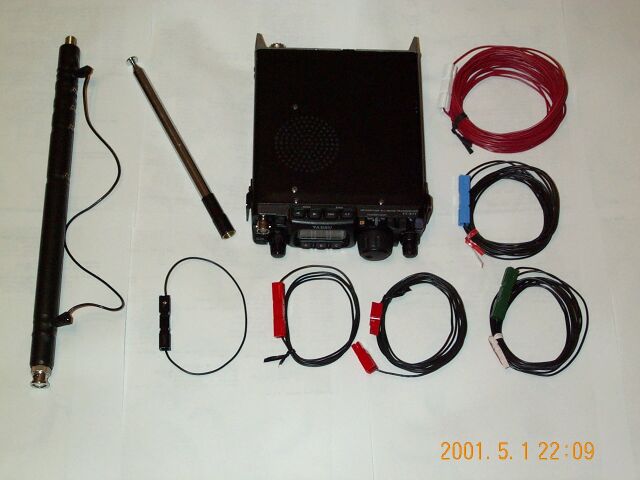
Radial/Counterpoise Kit (Dale-W8ABZ)

QRP or Helpful Portable Hint (SAR?): Counterpoise Kit for FT-817 with ATX-Walkabout Antenna
I am one of the many hams who has purchased the Yaesu FT-817 Backpack Portable and found that it, indeed, brings the fun back into amateur radio. I carry it with me in my computer bag daily to and from work. And my notebook PC has RITTY, ChromaPix, DigiPan, Stream, AGWPE, WinAPRS and several other ham applications loaded, so I'm pretty much always ready for emergency or non-emergency (like demonstration) operations. And with a few presentations (in Microsoft Powerpoint) always at the ready, I've managed to get tapped to speak at a couple of club meetings while on business travel! One of the items that completes the portable setup is the Watson ATX-Walkabout antenna. I found out about this antenna after reading about SV1UY's record-breaking pedestrian mobile QRP contact in the e-mail ARRL Letter. (Yes, I know this is WorldRadio, but I am an ARRL member and read the League's news, too!) I went to check out Demetre's web site (http://www.athnet.ampr.org/~sv1uy), and there he mentioned this antenna. It's available at the Waters & Stanton PLC web site (http://www.wsplc.com). The ATX-Walkabout looks like a little brother to the Outbacker series of antennas. I've used the Outbacker Perth Plus and Outreach, both excellent antennas. The ATX has a similar tap arrangement, but has a BNC connector on the bottom instead of the 3/8-24 thread, and has a telescoping upper part instead of a whip. The whole thing breaks down to about a foot long and easily fits in the computer bag. The manufacturer of this antenna recommends (for very good reason, right Kurt?) that a counterpoise be attached to the ground lug of the FT-817 for best operation. The length of the counterpoise wire, of course, depends on the frequency, and a table of lengths vs bands is provided with the antenna. Rather than carry all those lengths of wire, I decided that something with a few wire segments with quick disconnects would roll up a lot smaller. The trick was figuring out a small set of wire lengths that would add to give all the lengths needed. I don't claim to have the "mathematically optimal" set of lengths, but below is the design I came up with. These are the lengths of the wire segments and the color coding of the quick-disconnect connectors: Black connectors: 10" Red connectors: 33" Yellow connectors: 77" Green connectors: 93" Blue connectors: 120" White connectors: 296" ...plus a very short wire with a spade lug to a connector, which I leave on the back of the radio always ready. For a given band, the length of the counterpoise = 180 feet / F (MHz). (Yes, it's shorter than a quarter wave. See the explanation at the W&S web site...) All combinations work out to the length recommended by the manufacturer except as shown below. Band Length Wire Segments vs Mfr. recommended ----------------------------------------------------------------------- 6m 43" Black + Red (as recommended) 10m 77" Yellow (as recommended) 12m 87" Black + Yellow (as recommended) 15m 103" Black + Green (as recommended) 17m 120" Blue (as recommended) 20m 153" Blue + Red (recommended = 154") 30m 213" Blue + Green (recommended = 216") 40m Phone 296" White (not specified) 40m CW 306" White + Black (recommended = 309") 75m G Phone 552" All except Yellow (not specified) 75m A/E Phone 586" All except Black and Red (not specified) 80m Data/Novice 596" All except Red (not specified) 80m CW 619" All except Black (recommended = 618") (U.S. bandplan shown) Notice how you never have more than two wire segments until you get to 75/80m. Of course, other combinations can be assembled for SWL or other purposes. The whole package of wires and connectors rolls up to about the size of a small donut or bagel. I used Anderson Powerpole connectors because they are available with the required shell colors, they are "genderless", but mostly because they are very well engineered. They are popular with search-and-rescue operations and local ARES groups, as I learned from the APRS SIG at tapr.org -- repeatedly! (The Powerpole connectors seem to be a recurring topic of heated debate on the SIG for some reason... :-) Of course, I wouldn't suggest this design if I hadn't tried it. A 5-9 report from S57IIO on 15 meters the first weekend of May from the picnic table in my backyard is typical. There's only one other thing I want to add to this kit. I'd like to get some small clips (or maybe hook/loop fastener straps in kind of an "H" shape -- these could be used for rolling up the wires too!) to use for locking the connectors together so you don't lose most of the wire when you drop it out that hotel window! Other quick disconnects can be used, but I strongly recommend the Anderson Powerpole connectors for repeatably reliable connections and ease of color coding. The counterpoise wires and a copy of the color chart above, tucked in a small zipper-locked plastic freezer bag, now have a permanent place in my portable station. I hope you will find them useful too! [Attached is a photo of the FT-817, the ATX antenna (two pieces, coil/tap unit and separate telescoping whip), and the Counterpoise Kit. Unfortunately I had no yellow Powerpole connector shells, so I used red ones for the wire that should have yellow shells. Hey, it's just a prototype! BTW, the green connectors are very dark green, and they look almost black in the photo, but they are, in fact, green.] Dale, W8ABZ Cleveland Heights, Ohio USA EN91


 Return to SV1UY's Home Page (Radial/Counterpoise Kit (Dale-W8ABZ))
Return to SV1UY's Home Page (Radial/Counterpoise Kit (Dale-W8ABZ))
